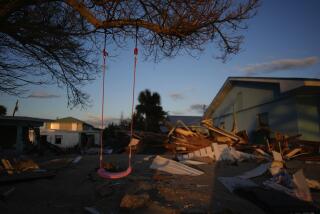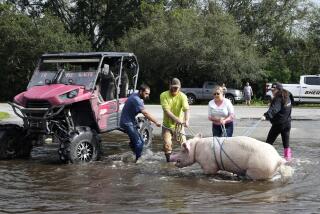Insurers’ Estimated Loss on Andrew Sets a Record : Insurance: The industry may lose $7.3 billion in Florida alone. That would make the hurricane the costliest U.S. disaster.
Insured damage from Hurricane Andrew will reach $7.3 billion in Florida alone, making the killer storm the costliest disaster in American history, an insurance industry group said Tuesday.
An estimated 685,000 home, auto and business claims will be filed in Florida, whose southern tip was ravaged by Andrew’s 150-m.p.h. winds Aug. 23 and 24. The claims and damage estimates are the first official projections by the insurance industry.
Damage estimates for Louisiana, where the storm struck two days later, will be available later this week, Gary R. Kerney, director of catastrophe services for the American Insurance Services Group, said in a press conference in Miami.
Analysts expect the losses to cause property/casualty insurance rates to climb as much as 10% in southern Florida, but they are split on the likely effect on premiums nationwide.
There is a consensus that the industry is strong enough financially to absorb the blow from Andrew and whatever else may follow in this hurricane season.
“Bottom line, the industry has capacity to handle not only Andrew . . . but we can handle what normally happens if two or three (other) hurricanes hit the mainland of the United States,” said Sean Mooney, economist for the Insurance Information Institute.
Still, Andrew’s wreckage pushed 1992’s insured-loss total to $11.2 billion, making this the worst year on record. The old mark of $7.6 billion was set in 1989, when Hurricane Hugo and the Loma Prieta earthquake occurred.
Not counted in Tuesday’s estimate is uninsured damage to military facilities and other government and public property, including roads, bridges and utilities. Also excluded is the cost of emergency services and such economic losses as erosion of the tax base and any drop-off in tourism. Florida officials have estimated that the total costs could surpass $20 billion.
In Dade County, the hardest hit area, insured damage was estimated at more than $6 billion.
Mooney said nearly 45% the insured losses will be covered by domestic and foreign reinsurance companies. Insurance companies pass on a portion of their risk by buying policies from reinsurers.
“After reinsurance and tax benefits, I estimate that the actual impact of the storm will be not more than 1%,” said Gerald Lewinsohn, an analyst for Merrill Lynch Global Securities. He was referring to the reduction in the industry’s capital and surplus.
“Despite the catastrophe, the industry’s surplus has never been larger,” agreed analyst Michael Frinquelli of Salomon Bros. Although many companies continue to lose money on their actual underwriting of property/casualty insurance, he said, the strong bond and stock markets have bolstered their portfolios and made them profitable overall.
A spokesman for a trade group said he does not expect widespread insolvencies even among smaller insurers. “Small- and mid-sized insurance companies have traditionally been conservatively managed, which makes them extra strong financially,” said James Taylor, southeast regional manager of the National Assn. of Independent Insurers.
Neither Lewinsohn nor Frinquelli expected Andrew to cause an end to the current lengthy cycle of flat or falling premium rates among property/casualty insurers.
Last week, however, Kidder Peabody & Co. analyst Steven Gavios issued buy ratings on the stocks of several blue chip insurers, arguing that the hurricane would lead to higher premiums, boosting company profits.
The American Insurance Services Group’s loss estimate was based on aerial and ground observation of storm-damaged areas as well as surveys of insurance companies. Most companies said they were still trying to get a handle on their losses Tuesday and would not offer official estimates until later.
State Farm, by far the largest insurer in the affected area, made a “very preliminary” estimate that its losses could reach $750 million. Travelers Corp. estimated that after reinsurance and tax calculations, losses from Hurricane Andrew will cause a $70-million charge against third-quarter earnings. In the third quarter of 1991, Travelers posted earnings of $65 million, or 60 cents a share.
Mulligan reported from Los Angeles and Virtue from Miami.
Top 10 Insured U.S. Catastrophes
Even before damage estimates from Louisiana arrive, Hurricane Andrew has topped 1989’s Hurricane Hugo as the costliest disaster in U.S. history. Loss totals are not inflation-adjusted.
Estimated Insured Loss Rank Date Event (in millions) 1 August, 1992 Hurricane Andrew $7,300 2 September, 1989 Hurricane Hugo 4,195 3 October, 1991 Oakland fire 1,200 4 October, 1989 Loma Prieta earthquake 960 5 December, 1983 Wind, snow in 41 states 880 6 April-May, 1992 L.A. riots 775 7 September, 1979 Hurricane Frederic 753 8 August, 1983 Hurricane Alicia 676 9 July, 1990 Wind, hail in Denver 625 10 September, 1965 Hurricane Betsy 515
Source: American Insurance Services Group Inc.










